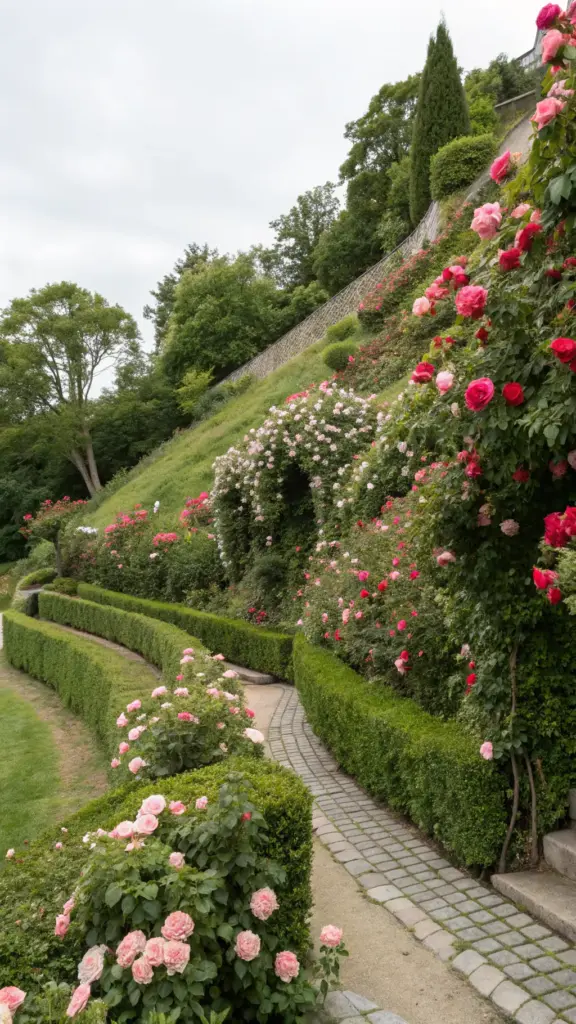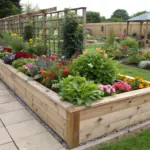5. Rose Garden Elegance: Transforming Your Hillside into a Blooming Paradise

There’s something undeniably romantic about roses. Whether it’s the way they catch the light or their intoxicating fragrance, roses have a way of turning any space into a scene straight out of a storybook. But when it comes to planting them on a hill, you’ve got some decisions to make—especially between climbing roses and shrub roses. I’ll admit, I’ve made my fair share of mistakes (hello, overcrowded trellises!), but over time, I’ve learned how to create a rose garden elegance that’s both stunning and manageable. Let me share what I’ve learned with you.
Selecting Climbing Roses vs. Shrub Roses for Hills
Choosing between climbing roses and shrub roses depends on the look you’re going for and the structure of your hill.
If you want drama and vertical interest, climbing roses are your best bet. They’re perfect for hills because they can cover slopes in a cascade of blooms, especially when paired with supports like trellises or arches. On the other hand, shrub roses are more self-sufficient and spread horizontally, making them ideal for creating lush, ground-covering layers.
I once planted climbing roses without any support structures—big mistake. They sprawled everywhere, looking more chaotic than charming. Lesson learned: know your roses and plan accordingly. For steep hills, climbing roses add elegance, while shrub roses provide stability and coverage.
Building Support Structures for Climbing Varieties
If you’re going with climbing roses, you’ll need to build (or buy) some sturdy support structures. Trellises, arches, and even pergolas can elevate your hillside garden from “nice” to jaw-dropping.
When I first started, I went the DIY route and built a simple wooden trellis. It worked okay, but after a few years, the wood started to warp under the weight of the roses. Now, I swear by metal or vinyl trellises—they’re durable, weather-resistant, and practically maintenance-free. Arches are another favorite of mine; they create a magical pathway effect, especially when covered in blooming roses.
Pro tip: Anchor your supports deeply into the ground to prevent them from toppling over as the roses grow heavier. Trust me, you don’t want to deal with a collapsed trellis mid-season.
Companion Planting Ideas to Enhance Visual Appeal
Roses are beautiful on their own, but pairing them with companion plants takes things to the next level. My go-to companions? Lavender and salvia.
Lavender not only complements the soft pastels of many roses but also attracts pollinators and repels pests like aphids. Salvia, with its spiky blooms, adds height and texture, creating a dynamic contrast against the lushness of the roses. I also love planting low-growing herbs like thyme around the base of my roses—it fills in gaps and smells amazing when you brush against it.
One word of caution: avoid planting anything too aggressive near your roses. Mint, for example, spreads like wildfire and can overwhelm even the hardiest rose bushes. Stick to well-behaved companions, and your garden will thank you.
Pruning and Fertilizing Tips for Healthy Roses
Let’s talk about keeping your roses happy and healthy year-round. Pruning is key—trust me, I’ve skipped it before, and the results were… less than ideal.
For climbing roses, prune in late winter or early spring, removing dead or weak stems to encourage new growth. Shrub roses are a bit more forgiving, but they still benefit from an annual trim to maintain shape and airflow. Always use sharp, clean pruners to avoid damaging the plant or spreading disease.
As for fertilizing, roses are heavy feeders. I use a balanced, slow-release fertilizer every 6-8 weeks during the growing season. And don’t forget mulch! A layer of organic mulch around the base helps retain moisture and keeps weeds at bay.
Here’s a little secret: I sprinkle a bit of Epsom salt around my roses once a month. The magnesium boost promotes vibrant blooms and lush foliage. Just don’t overdo it—one tablespoon per plant is plenty.
Alright, ready to dive into the world of hydrangeas? Click the next button below to discover how these versatile beauties can bring bold color and texture to your hillside garden. Spoiler: they’re easier to grow than you think, and the results are absolutely breathtaking!









GIPHY App Key not set. Please check settings